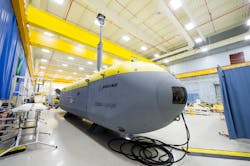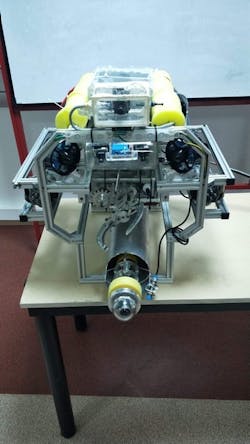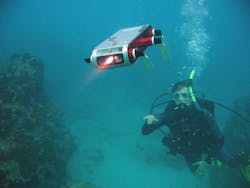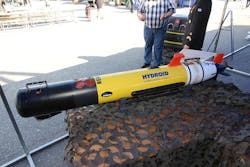Unmanned submarines seen as key to dominating the world’s oceans
By JR Wilson
The Spanish and British empires dominated the world in large part by dominating the oceans. Nazi Germany and Imperial Japan were major sea powers during World War II by adding submarines to their surface fleets.
That combination remains the key to sea power today, dominated by the U.S. Navy, with 68 nuclear-powered submarines, 11 aircraft carriers, and more than 450 other ships like destroyers, cruisers, and support ships.
In recent years, China has overtaken the U.S. in numbers, with more than 500 ships, including 75 submarines and three aircraft carriers, of which about half has been built since 2010. Still, China’s open-ocean naval capability lags far behind the U.S. No other navy in the world comes close to the U.S. or China. Now a new era in naval power is emerging — unmanned vehicles.
Nearly two decades into the 21st Century, both nations are putting significant effort into adding autonomous and semi-autonomous platforms to their surface and subsurface naval forces. The underwater realm is the most difficult because of the limitations of underwater communications, which makes some form of artificial intelligence (AI) mandatory.
China has been uncharacteristically open about its intentions for AI, from an announced underwater city inhabited and operated entirely by robots to official government goals of capitalizing on AI to transform their military into the strongest in the world.
While Chinese government spending on AI research is far greater than that of the U.S., however, a large percentage of global effort is coming from the U.S. commercial sector, on which the Pentagon relies heavily for technology advances. Still, Chinese companies also are increasing their AI investments.The influence of massive spending on developing AI for undersea systems portends the greatest change in military sea power since the introduction of nuclear-powered vessels.
“Equipping our military vessels with a higher-level of artificial intelligence is the answer to the increasing size and complexity of data to be processed as well as the need to reduce staff,” says Dominique Giannoni, an executive at Thales Underwater Systems in Valbonne, France.
China autonomous undersea efforts
In a rare July 2018 interview with the South China Morning Post, Lin Yang, director of a classified program at the Shenyang Institute of Automation in Shenyang, China, says her country has plans to develop new-generation military underwater robots by 2021. His 912 Project’s goal is to develop AI-driven unmanned submarines to handle surveillance, mine laying, and attack missions.
Western China-watchers say the Chinese navy has several AI-enabled vessels in development — with a focus on autonomous submarines — as part of a major push to overtake U.S. dominance in the Indo-Pacific region and beyond. That includes 100-foot long extra-large unmanned underwater vehicles (XLUUVs) intended for deployment early in the next decade.
Another civilian project is China’s most ambitious undersea AI effort to date, with significant military potential. In 2018, China announced it was working on an AI-run underwater base, equipped with autonomous submarines to extend its reach.
According to published reports, the submarines would deploy for investigation and scientific surveillance missions, then return to the unmanned base to download data and recharge. The base itself, located on the ocean floor as deep as 36,000 feet, also would conduct research on the immediate area, process and fuse all collected data, and transmit the results to a surface ship or land station.
No location for the base or a timetable for its deployment have been released, but, given the speed with which China is developing AI across the board, and especially for undersea applications, the first elements are expected in the near future.
While being promoted as a major advance in research on undersea life and topography, the military potential of such long-endurance unmanned cooperative systems cannot be ignored.
Russia also is putting considerable effort into AI, but is not believed to be anywhere near the level of the U.S. or China.
U.S. autonomous undersea programs
The 2020 Pentagon budget request cites advances of potential adversaries in asking for major funding increases for autonomous weapons programs. Requests include a ten-fold increase in spending on large unmanned surface vessels by the Navy and more than 50 percent more for Army robotics development. The requests total $3.7 billion on unmanned systems across the services, plus another $900 million on AI.
The Embracing Artificial Intelligence in Undersea Warfare session at the Navy Submarine League’s Submarine Technology Symposium in May summarized the U.S. Navy’s increasing focus on AI — especially undersea:
“As the current submarine force trusts mechanical and electrical technology to execute the mission, the future force will need to trust AI to extract and exploit actionable patterns among an ocean of data,” the session says. “The advent of big data and deep learning technology has rendered signal detection and classification an increasingly automated process. Furthermore, advances in autonomous navigation have enabled unmanned platforms to operate alone or in swarms.
“It will be critical for the 21st century that the undersea fleet advance in its AI capabilities, develop algorithms that are intuitive and explainable, cultivate users’ trust in AI, and design future systems around the use of AI. Meanwhile, we must also recognize our adversaries’ disruptive AI capabilities and develop appropriate countermeasures against them.”
“Achieving and maintaining communication with underwater vehicles and even with surface vehicles is technically challenging, especially at longer ranges. Water attenuates radio waves and other wireless signals that can easily be used at long range in air-to-ground or air-to-air communications,” the report stated. “This means that high-bandwidth communications underwater are largely impractical using traditional communication technologies.”
“Although there has been some experimentation with laser communications for underwater applications, laser communications systems are expensive and consume considerable amounts of power. Because of these communications limitations, UUVs that do not require continuous communications links are essential. For example, autonomous path planning is needed to avoid underwater obstacles and unanticipated terrain features.”
The report listed “moderate levels of autonomy” in U.S. Navy UUVs today, including:
The report also notes that incompatible communications systems in the past have hampered UUV interoperability.
In the underwater domain ... achieving interoperability is currently impossible due to the lack of common standards and protocols for wireless communication.
Almost all underwater vehicles or sensors currently use proprietary interfaces and protocols for communication, especially for wireless communication in water.
This implies that UUVs made by different manufacturers cannot communicate with each other, even if they operate in the same area, and human operators afloat or ashore cannot control these UUVs unless they use the control systems supplied by each manufacturer.
“The NATO Center for Maritime Research and Experimentation in La Spezia, Italy, is working with industry to develop communications standards and encourage development of software-defined modems and networks for UUVs and UUV control systems,” the report noted.
“CARE and industry have worked together to develop the JANUS open source communications standard for UUVs. JANUS is far from a complete architecture for UUVs, but it does provide a necessary and important starting point for improving UUV interoperability.”
UUV development programs
By far the most active in autonomous, AI-driven platform development and deployment, the Navy already has awarded $43 million in contracts to Boeing Defense, Space & Security in Huntington Beach, Calif., and Lockheed Martin Rotary and Mission Systems in Riviera Beach, Fla., for extra-large unmanned undersea vehicles (XLUUVs).
Boeing will build four Orca XLUUVs, based on their Echo Voyager diesel-electric submersible. The 51-foot Orca has a range of 6500 nautical miles and can perform several combat missions, including anti-submarine and anti-surface warfare.
Mine warfare is another area where AI submersibles represent major technological advances in using intelligent collaborative autonomy to enable a group of autonomous UUVs to conduct the complex operations needed to survey and clear an underwater mine field. Many nations — friend and foe — have large stockpiles of such mines, which provide a cheap and easily deployable way to block access to ports, harbors, and shipping routes.
Thales is among those working on anti-mine autonomous UUVs under a program called “Explainable and Trustable Artificial Intelligence,” designed to enable manned and unmanned systems to make informed decisions in military applications.
Multi-agent systems (MAS) are being designed to address significant challenges in intelligent control in collecting simultaneous data points from a large ocean volume as part of a coordinated mine sweep. Those include automated planning and replanning, context-sensitive reasoning, unanticipated event handling, inter-agent communication, autonomous organization, and reorganization of multi-autonomous undersea vehicle (AUV) systems and task allocation.
Adding autonomous AI-controlled submarines to the Navy’s combat fleets, however, is expected to provide political as well as technological challenges.
New challenges
The Pentagon’s Defense Innovation Board has requested public and professional input on developing a “set of principles for developing, testing and deploying” AI systems, but how those would be integrated into ongoing and future developments is unclear.
One undersea AI goal involves swarming capabilities, in which several autonomous vessels team with each other, as well as with manned submarines, surface vessels, and aircraft. One such vessel is SwarmDiver, manufactured by Aquabotix Technology Corp. in Fall River, Mass. The SwarmDiver test vehicle can dive as deep as 600 feet while working in synch with other UUVs submersibles.
“The swarming algorithm allows vehicles to communicate with each other to make decisions as a group. This allows SwarmDiver to quickly and accurately self-arrange in various swarm formations, as well as dive simultaneously to collect synoptic data sets,” according to Aquabotix.
Pentagon research and acquisition procedures also are being changed to reflect the rapid evolution of AI technology and undersea applications. The Other Transaction Authority was created to speed up the prototype permitting process, making it more flexible and efficient to move new technologies from the lab to the fleet as quickly as possible. Under the old process, a UUV would be obsolete by the time its requirements were laid out.
“This will streamline priorities,” Sen. Jack Reed D-RI, ranking member on the Senate Armed Service Committee, told the Middletown, RI-based Undersea Technology Innovation Consortium. “We’ve got to be quicker, faster, and tap into small business innovation.”
Among the Pentagon’s growing body of research is the Defense Science Board’s Task Force on Counter Autonomy. A committee of civilian experts, the task force is assessing near- and long-term U.S. counter-autonomy capabilities on land, at sea, in the air, and in space and cyberspace.
“Advances in artificial intelligence and global technology proliferation are driving the rapid evolution and global adoption of autonomy, which is creating economic, social and military disruption,” wrote Mike Griffin, U.S. undersecretary of defense for research and engineering.
The Navy also is moving forward with its new Unmanned Maritime Autonomy Architecture (UMAA) program to evaluate levels of autonomy in unmanned submarines, enable commonality of autonomy technologies, and reduce acquisition costs.
Changing ocean warfare
Autonomy will bring significant changes to undersea warfare, from longer range and endurance attack and surveillance operations amid minefields, enemy submarines and UUVs, to being able to strike undersea, surface, or land targets with improved targeting at long ranges.
Such missions will require new and advanced capabilities, from seamless, real-time communications among UUVs and motherships, to an advanced undersea “GPS-like” capability, currently being developed by the U.S. Defense Advanced Research Projects Agency (DARPA) and BAE Systems.
“Developers have built highly autonomous systems that can navigate, maneuver, and carry out surprisingly complex tasks. Operating above or near the surface simplifies the power and control, but compromises stealth,” according to a National Academy of Sciences essay titled “Military Robotics: Latest Trends and Spatial Grasp Solutions.”
While dependable and deployable AI remains an elusive goal, the prospect of imminent breakthroughs and subsequent demands for its employment is a vast array of military systems and missions also has led to increased concerns about ethics, especially for autonomous military systems with weapons capability.
From fundamental issues like discriminating between friendly and unfriendly targets in a congested battlespace, to issues of what thought processes AI must use to unleash deadly force — the coming AI Age is fraught with technological, philosophical, ethical, and human concerns.
AI vs. human reasoning
“We know why humans may mess up a decision; there’s no intuitive way to know when machines are wrong,” says Bill Ferguson, lead scientist at Raytheon BBN Technologies in Cambridge, Mass., for the DARPA Explainable Question Answering System (EQUAS) project.
“To build trust, we have to give the user enough information about how the recommendation was made so they feel comfortable acting on the system’s recommendation,” Ferguson says.
That is even more crucial if the machine acts on its own. EQUAS will show users which data mattered most in AI decision-making. Users also can ask the system questions about chosen recommendations and discover why it rejected others, Raytheon officials say.
Another DARPA effort to improve undersea autonomy, with major military implications, is Angler — a robotic system using AI to autonomously navigate and survey the sea floor and physically manipulate manmade objects on long-distance missions.
One major effort is DARPA’s Lifelong Learning Machines (L2M) program.
“The L2M program’s prime objective is to develop systems that can learn continuously during execution and become increasingly expert while performing tasks, are subject to safety limits and capable of applying previous skills and knowledge to new situations, without forgetting previous learning,” Program Manager Dr. Hava Siegelmann notes on the DARPA website.
“We’re at a major moment of transition in the field of AI. Current fixed methods underlying today’s smart systems will quickly give way to systems capable of learning in the field. The missing ingredients to safer, more flexible and more useful AI are the abilities to learn while in operation and to apply learning to new circumstances for which the system was not previously trained.”
L2M could take undersea AI to significant new levels for long-distance, long-endurance missions in complex and congested areas of operation. By having the onboard ability to adapt to new circumstances, an AI UUV could retain a high level of functionality despite an enemy’s changes to his own systems or capabilities, sub-surface and surface.
As with any computer-based system, artificially intelligent UUVs would be subject to enemy efforts to defeat them, including attempts to take control of the AI and possibly turn the system against its owners. To counter such attacks, DARPA is developing GARD, which is short for Guaranteeing AI Robustness against Deception.
“Over the last decade, researchers have focused on realizing practical machine learning [ML] capable of accomplishing real-world tasks and making them more efficient,” DARPA’s Siegelmann says. “We’re already benefitting from that work and rapidly incorporating ML into several enterprises. But, in a very real way, we’ve rushed ahead, paying little attention to vulnerabilities inherent in ML platforms — particularly in terms of altering, corrupting or deceiving these systems.
“There is a critical need for ML defense as the technology is increasingly incorporated into some of our most critical infrastructure,” Siegelmann continues. “The GARD program seeks to prevent the chaos that could ensue in the near future when attack methodologies, now in their infancy, have matured to a more destructive level. We must ensure ML is safe and incapable of being deceived. The kind of broad scenario-based defense we’re looking to generate can be seen, for example, in the immune system, which identifies attacks, wins and remembers the attack to create a more effective response during future engagements.”
That infrastructure also is under attack by nature — wind, waves, currents, wakes from passing boats, and swirling eddies, which opens another avenue of development for undersea AI platforms. Researches at Stevens Institute of Technology in Hoboken, N.J., are working on software to teach robots how to adapt to those ever-changing dynamics to protect and preserve the nation’s piers, pipelines, bridges and dams.
The team leader, Brendan Englot, a professor of mechanical engineering, says the underwater robot has to deal with disturbances pushing it around as it tries to establish the situational awareness to conduct inspections and repairs. The first task is being able to navigate with confidence, currently done with sonar, which has serious limitations in such environments.
According to Englot, some of the greatest challenges in robot autonomy are underwater.







